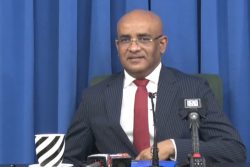Tumatumari Hydro Inc. (THI) has submitted an application to the Environ-mental Protection Agency (EPA) for the rehabilitation of the Tumatumari hydro-power plant, which will hinge on the outcome of an environmental impact assessment.
According to an EPA advertisement published in Thursday’s edition of the Stabroek News, THI has submitted an application for environmental authorisation to undertake the rehabilitation of the Hydroelectric Power Generation Plant, located on the Tumatumari, Potaro River, Region Eight.
According to the ad, the project would see the redevelopment, operation and maintenance of the existing Tumatumari Hydro-electric Power Station. It would also entail the replacement of the existing hydroelectric generator units and installation of new electro-mechanical/ hydraulic controls, instrumentation, and protection and switch gears.
The project would also see the re-conducting of theexisting power lines from Tumatumari to the Sucre Junction; the construction of a new power line extension from the Sucre Junction to Mahdia; the construction of a new 30 KM power line from Tumatumari to TRG gold mining operations at Karouni; and the rehabilitation of damaged sections of the concrete gabion spillway and the restoration of sluices, which will be remotely controlled and electro-mechanically controlled.
In keeping with the Environmental Protection Act, an Environmental Impact Assessment (EIA) is required for the redevelopment of the project before any decision is made on whether the application is approved or rejected.
As a result, members of the public are invited, within 28 days, to make written submissions to the Agency, highlighting questions and matters that they require answers to with regards to the EIA.
THI is a private company with a 50-50 partnership between local and regional investors.
Director of THI Herman Rohlehr, at a forum at the Arthur Chung Convention Centre on July 31, 2015, had disclosed that the company was set to start initial operations in the second half of 2016. “We look forward to having hydroelectric power on a modest scale in place by the end of July of 2016,” he was quoted as saying in a Government Information Agency (GINA) report.
Rohlehr had said THI had negotiated a power purchase agreement with the Mahdia Power and Light (MPL) Limited. The agreement provided for bulk electricity to be sold to MPL, which would in turn retail it to consumers.
GINA had noted that the rehabilitation of the plant was one element of the Tumatumari Industrial Development Project, which was aimed at establishing natural resource-based industrial operations utilizing existing endowments of water, forest and minerals in Region Eight.
Phase one of the project entails rehabilitation of the hydroelectric plant to deliver 1.5 megawatts of power and the construction of two 30 kilometer power delivery lines, while Phase two will see the facility expanded by the addition of two more 0.75-mega-watt turbines. The primary consumers would be from Mahdia and contiguous communities including Tumatumari and Micobie, and Troy Resources Guyana Gold Mining operations. It has a projected tariff rate of US18 cents for a kilowatt of power.
Rohlehr had told the forum that the company intended to spend US$5M for the two phases.
He had also stated that the rehabilitation project also catered for an additional 300 consumers in the planned Mahdia housing scheme development as well as another 80 consumers in adjacent communities along the power line extension, including the Amerindian villages of Micobie and Princeville.
Rohlehr explained that the overarching Tumatu-mari industrial development project included two other components: Tuma-tumari Lumber Inc, which would be engaged in the building, drying and finishing of lumber; and a quarry project that would provide for dimension stones, which would be mined, cut and polished into black granite. These operations would be adjacent to the hydroelectric power station, Rohlehr said, while noting that together, their upstream development will bring investment, value-added natural resource based industries, underpinned by cheap and reliable energy.
The hydroelectricity plant at Tumatumari Falls on the Potaro River was the first hydropower station in Guyana and was constructed by British Guiana Consolidated Goldfields Limited to power two large dredges for gold mining there and at Konawaruk in the mid-1950s. It was said that it had an installed capacity of 1500kW and used 2 x 750kW Francis turbines. Following a prolonged workers’ strike, the operations were closed in the early 1960s but put back into use in 1976 by the Guyana National Service to supply power to its administrative centre and other activities. Up to 1987, one turbine functioned. It is 241 feet above sea level.









